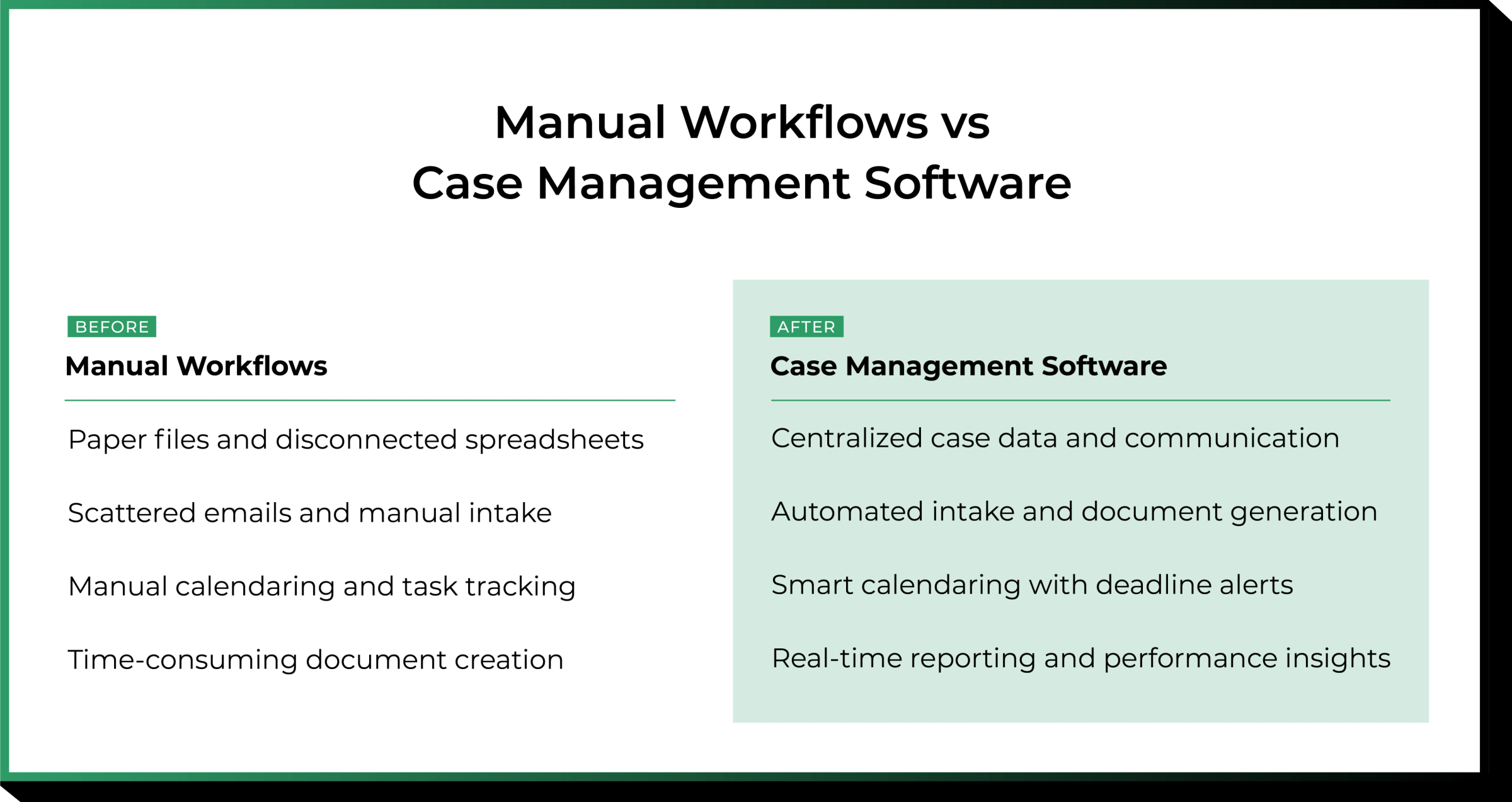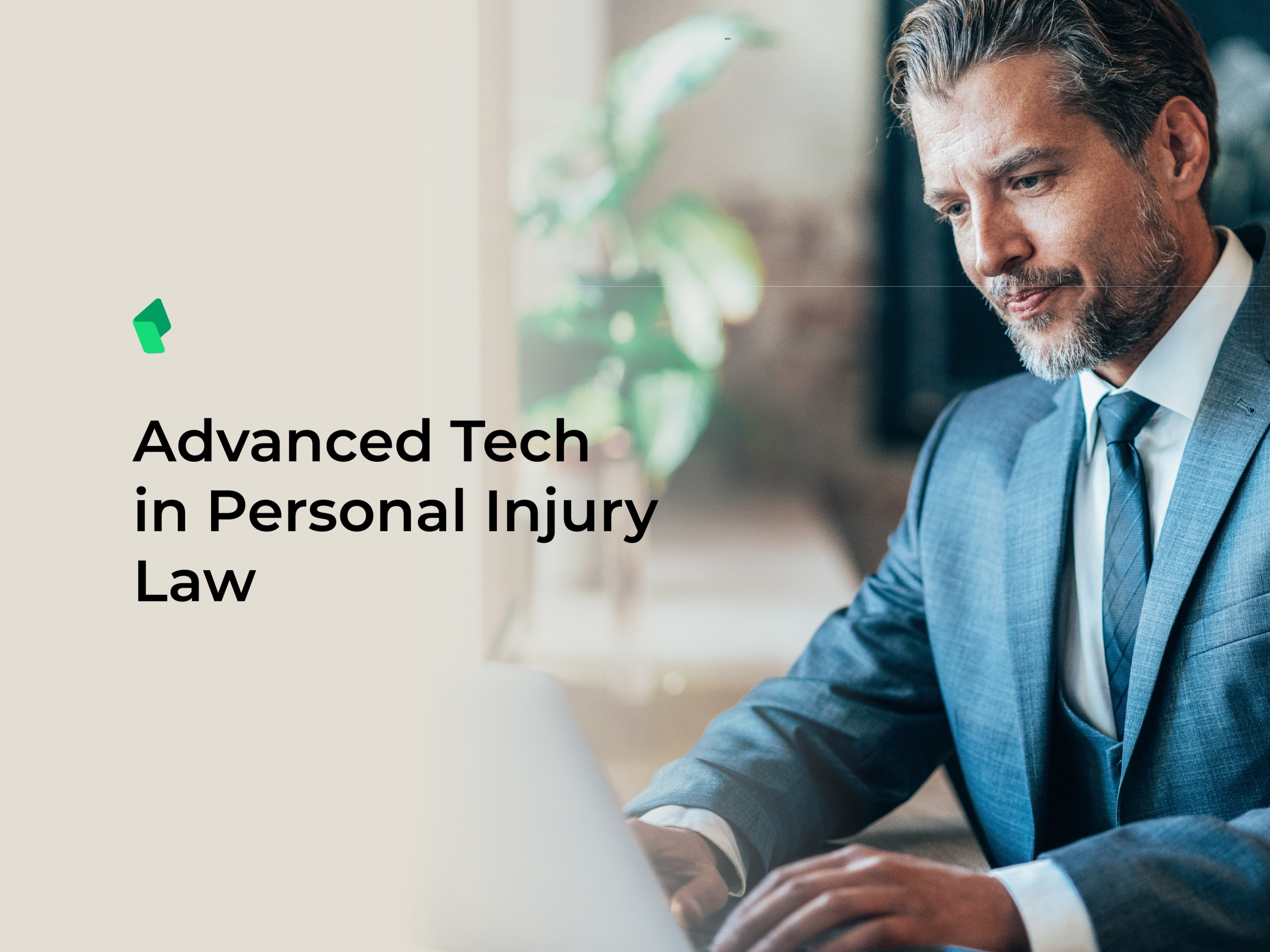Working in personal injury law can feel overwhelming. Between managing cases, researching and gathering evidence, and creating and filing legal documents, personal injury lawyers also have to grapple with large volumes of admin work. As if those tasks weren’t enough, a growing firm needs to allocate time to legal marketing and lead capture to grow its list of clients.
While many firms try to tackle these challenges by hiring more assistants and paralegals, this approach ultimately pours money into the same manual processes and outdated technologies that are holding them back.
Firms that don’t embrace the latest innovations in legal technology risk being left behind. Until recently, industry-specific tools were harder to find or simply out of reach for all but the biggest law firms.
Today, that isn’t the case. Advanced technologies in personal injury case management are changing the game for law firms, making it easier to streamline daily operations, deliver a better client experience, and boost cash flow. These tools give firms of all sizes the power to work more efficiently and scale with confidence.
By fully understanding what law firm technology is available and how it’s being used, your firm can find new ways of working and unlock its full potential.
The Shift to Automated Personal Injury Case Management
These days, most people are comfortable doing nearly everything online, from shopping for groceries and looking up new businesses to renewing passports or booking travel. The convenience of connected experiences isn’t contained to consumer goods and services—it’s created some major shifts in the legal industry.
Before, clients were happy to trust a firm based on reputation and wait patiently as their case moved through the system. That’s no longer the case. Today’s personal injury clients not only expect faster results, but also faster communications, easier payment options, and more transparency. Those shifting expectations are taking a toll on personal injury firms that are still relying primarily on paper records, emails, spreadsheets, and other traditional methods to manage their practice.
The good news is that next-gen devices and software aren’t just affecting clients, but ways of working as well. For many personal injury attorneys, technology has enabled many ways of speeding up client outcomes and cutting down on unnecessary admin, such as using remote offices and working with courts, insurers, medical professionals, and businesses through digital channels. This is bolstered by industry-specific technology like case management software, financial management tools, and legal AI, which can significantly streamline operations and level the playing field against bigger competition.
The wide adoption of digital tools in the legal industry has also led to the development of software that is oriented towards solving challenges that are unique to specific practice areas. For personal injury firms that are constantly sending out representation letters, organizing and analyzing documents, and preparing for trial, these tools have become essential to delivering the more collaborative, client-focused services people expect.
Advanced Personal Injury Case Management Tools Driving Efficiency
When it comes to how personal injury lawyers get work done today, nothing has made a bigger impact than case management software. At its core, case management software consolidates, organizes, and tracks key information related to specific cases. In addition to making documents and communications more accessible, it also helps firms productively manage the business side of their law practice.
The key features of a typical case management system include:
Automated calendaring, statute notifications, and deadline tracking
Secure document management
Streamlined document creation and task workflows
Built-in cost tracking and time tracking
Streamlined intake management and marketing tools
Reporting tools to visualize and track a firm’s performance
However, it’s worth noting that not all case management tools are created equal. While adopting any legal-specific case management tool is a step up from tracking information in scattered emails and file cabinets, many solutions aren’t tailored to common personal injury needs (e.g., demand letter generation, medical treatment tracking, lien management, etc.).
Here are some of the specific features that can help personal injury lawyers thrive.

Integrated Medical Records
Getting accurate and prompt access to medical records is essential for building a strong case. Delays in medical record retrieval can lead to missed deadlines and less negotiating power.
Having an established system in place helps mitigate risks like unexpected gaps in a client’s medical history, incomplete records, or missing documents by providing more visibility and automation throughout the process.
Medical records retrieval tools provide better access to information, even the ability to search records for relevant keywords. It also helps you to streamline retrieval by automatically filling out relevant details and storing them in ways that are fully HIPAA compliant.
Streamlined Treatment Tracking
Having a detailed record of a client’s injuries and treatments is essential for building a case and ensuring a smooth settlement process. Integrated treatment tracking gives personal injury attorneys helpful tools to prevent gaps in treatment, log visits and injuries, track finances, and more.
Not only can you get a general overview of your clients injury and treatments, you can also filter down into provider history, injury photos, lein holders attached to each provider, records requests, and other specific details.
In addition to creating a detailed medical history, integrated treatment tracking software can also send out helpful text reminders to clients so they maintain their treatment and are kept up-to-date on their rights before they go to important appointments.
AI and Automated Workflows
Personal injury lawyers have to deal with hundreds of documents, communications, and admin tasks on a daily basis. When these are done manually, it not only eats up a lot of time (much of which don’t count towards billable hours) but it can also increase the risk of errors or burnout.
Artificial intelligence (AI) and automation tools can speed up workflows can help assist with routine tasks, removing the need for manual data entry and follow-ups. Tools that handle streamlined document generation, automated tagging and organization, and task creation features can improve accountability and speed up tasks so lawyers and paralegals are freed up to work on more important things.
In the case of personal injury law, automation is often used to speed up the creation of demand packages or to review and tag discovery materials more efficiently.
Analytics tools can analyze your time and task data to show where you're working efficiently—and where there's room to improve.
Client Portals and Intake Tools
A smooth client intake process helps establish a positive client experience from the beginning of a case. Client management software includes many functions that enable smoother communications, provide self-service options, and enhance the overall intake process.
With the right legal technology, you no longer need to rely on scattered spreadsheets, emails, and paper records. Instead, you can keep all relevant information and related communications in one place.
This lets you quickly organize and prioritize leads, check for conflicts of interest, get necessary forms signed, and stay on top of communication. Self-service portals and integration with your client relationship management (CRM) tools also help create a speedier, more user-friendly intake process for clients.
How Advanced Technology Assists With Case Preparation
Technology isn’t just helping streamline administrative tasks—it’s also improving the way lawyers gather evidence, conduct research, and prepare for cases.
New legal AI tools have the ability to very quickly analyze and summarize vast amounts of information and can find patterns or spot discrepancies that would be harder for humans to detect.
It can also be used to cross-reference a matter with previous case law to find similarities or refute specific points. It’s worth noting that AI is an excellent tool, but it’s no replacement for an experienced attorney. AI weighs all sources equally, meaning that if the information it’s using contains biases or inaccuracies, it can lead to “hallucinations” where it asserts something is true without having the context to back it up.
In other words, AI is not an actual intelligent person that is using logic and experience to provide answers. It is a tool that can process vast amounts of data quickly in order to help your human experts do their work better. If used correctly, adopting AI in your personal injury firm can save significant amounts of time and effort.
Other technology has also entered the courtroom recently, including referencing social media posts, using photos and videos from a client’s smartphone, security footage, or even drone photography, which have all proved to be valuable tools for personal injury lawyers.
Virtual Tools for Case Presentation and Hearings
Until recently, if a case went to trial, lawyers primarily had to rely on photography, video (if they were lucky), and a jury’s imagination to present evidence.
Now, innovations in virtual reality (VR), augmented reality (AR), and 3D modeling are providing personal injury attorneys new ways to present evidence. For example, VR can be used to give judges and juries a fully 3D recreation of an accident site. Some solutions, like CASEpeer, also include integrations with Multus Medical, which use details from your case to create detailed animations of surgeries, injuries, and medical procedures.
These digital reconstructions help attorneys present injuries and evidence with additional clarity and impact that traditional visual aids sometimes lack. In depositions, these visual aids also reduce ambiguity for experts and opposing counsel. In other words, these tools are proving invaluable to better tell a client’s story while simplifying the facts for juries and judges.
Less impressive (but no less important) tools like remote hearings make it easier for experts and witnesses to provide testimony.
All of these technologies are helping lawyers achieve better outcomes and prepare more efficiently.
E-Discovery and Data Analytics
Discovery is a vital step in gathering evidence for a personal injury case, but it is often hampered by manually sifting through hundreds or thousands of pages of documents and files to find relevant information.
E-discovery is a digital investigation technique that analyzes relevant information (records, emails, social media, etc.) to find evidence that could be used in litigation. This information is then turned into legally compliant electronically stored information (ESI). E-discovery tools have significantly improved the way discovery is carried out by providing a better and faster process for organizing and analyzing relevant information.
Additionally, AI and analytics tools built into case management can analyze discovery ESI for patterns, keywords, timestamps, and other relevant information in a fraction of the time it would take manually. By drastically reducing manual review time, attorneys can focus more on higher-value tasks like argument framing and negotiation prep.
The top tech for managing personal injury cases also includes features that can help firms refine their overall strategy. Using predictive analytics, firms can determine how likely a case is to go to trial, estimate case value, or find which types of cases should be prioritized.
Wearables, Dashcams, and Surveillance Video in Case Evidence
As tech becomes more ubiquitous in our lives, so does its value as evidence in personal injury cases.
Wearables (smartwatches, smart rings, etc.), dashcams, and surveillance video offer accurate, real-time information that is difficult to ignore. For instance, a dashcam could show a driver running a red light without the need for witness statements or testimony. Similarly, a security camera could capture a flip-and-fall incident, countering any disputes about when and how an injury occurred.
In other words, these technologies allow lawyers to take a data-centric approach to building a case, reducing the reliance on subjective testimony.
Technology for Cybersecurity and Compliance for Personal Injury Firms
Access to data has made analyzing records and gathering evidence significantly easier. However, if not handled correctly, it can also open a personal injury firm up to risk.
To maintain legal and ethical compliance standards, your firm must follow data security best practices for everything, including:
Client communications, contracts, and invoices
Documents and records
Video and images
Medical records*
For medical records, it’s worth noting that HIPAA data security standards not only apply to medical professionals but to their “business associates”, including lawyers, meaning that your firm must meet HIPAA compliance standards as long as you hold any medical records.
This is another reason why it’s imperative to use legally compliant software when storing sensitive information to ensure data is secure and encrypted. Legal document management tools also include access controls to ensure only appropriate parties have access to certain information.
Failing to maintain data security not only risks expensive fines, but a single data breach can be devastating for a firm’s reputation.
Choosing the Right Tech Stack for Your Personal Injury Firm
Mastering the latest personal injury technology is essential to staying relevant and achieving better client outcomes. But while leveraging technology is essential, figuring out which solution is the best fit for your firm isn’t so easy.
When evaluating the top tech for managing personal injury cases, try to avoid one-size-fits-all solutions that might require you to either pay for functions you don’t need or spend extra time and effort customizing them to fit your needs.
Instead, look for case management software that is tailored to personal injury and includes features like:
Secure document management
Built-in treatment tracking
Streamlined cost and time tracking
Litigation tracking (tracking deadlines, discovery requests, etc.)
Calendaring, statute notifications, and automated task workflows
Integrated reporting
Legal AI support tools
Finally, make sure you don’t just look at a solution on paper but take some time to talk to providers and demo it thoroughly. You’ll be using your case management software every day, and it’s important that it is easy to use and intuitive.
Embracing the Future of Case Management
It’s no longer enough for lawyers to compete on outward appearance and reputation; they also need exceptional client experience, convenience, and speed.
Implementing advanced technology in personal injury case management is essential for meeting modern client expectations, improving outcomes, and reducing costs. However, technology, courtroom practices, and the law itself are constantly evolving—that means it’s vital to choose a forward-thinking technology partner.
CASEpeer is a cutting-edge and comprehensive solution for personal injury lawyers, built to meet the unique needs of personal injury firms today, tomorrow, and beyond. Combining powerful marketing, legal-specific AI tools, reporting, financial management, case management, and practice management features, we are constantly updating our solution to meet changing client expectations and help personal injury firms navigate an evolving technical landscape with confidence.
Schedule a CASEpeer demo today to see how embracing the latest technology can help your firm go further.
About the author

Justin Fisher Content Writer
Justin Fisher is a content writer and SEO strategist for leading legal software companies, including MyCase, Docketwise, and CASEpeer. He specializes in writing about emerging legal technology, financial wellness for law firms, and more.
